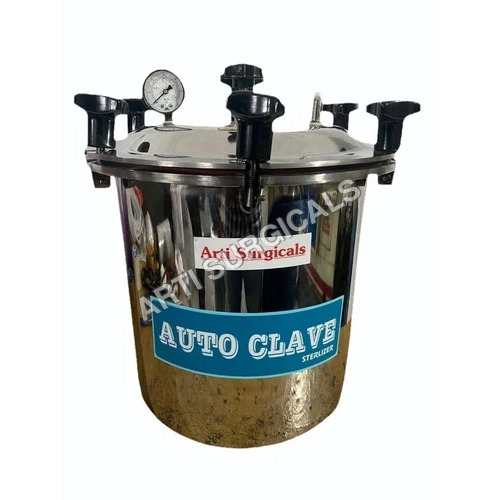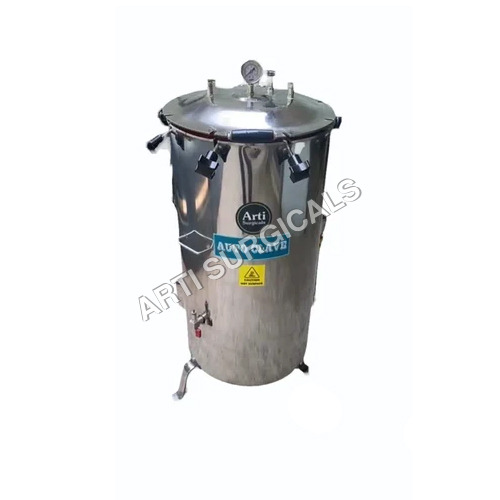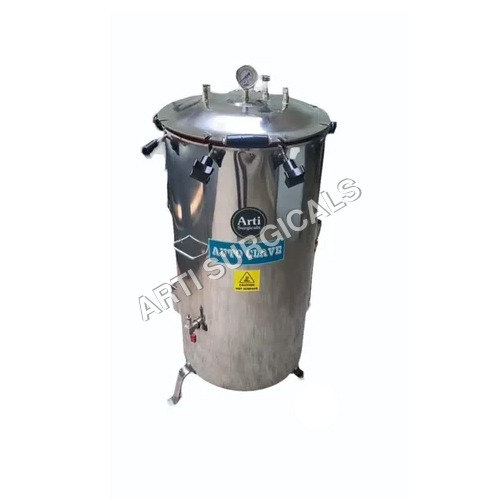
Autoclave Pressure Cooker
Product Details:
- Application Industrial
- Color Silver
- Voltage 220-240 Volt (v)
- Product Type Autoclave Pressure Cooker
- Operate Method Semi Automatic
- Usage Industrial
- Material SS
- Click to view more
Autoclave Pressure Cooker Price And Quantity
- 1 Unit
Autoclave Pressure Cooker Product Specifications
- 220-240 Volt (v)
- Industrial
- Semi Automatic
- SS
- Autoclave Pressure Cooker
- Industrial
- Silver
Autoclave Pressure Cooker Trade Information
- Cash in Advance (CID)
- 20 Unit Per Week
- Days
- Asia, Australia, Central America, North America, South America, Eastern Europe, Western Europe, Middle East, Africa
- , All India, South India, Central India, West India, North India, East India, Gujarat, Karnataka, Kerala, Lakshadweep, Mizoram, Meghalaya, Manipur, Andhra Pradesh, Bihar, Chandigarh, Daman and Diu, Goa, Jharkhand, Odisha, Punjab, Assam, Delhi, Dadra and Nagar Haveli, Andaman and Nicobar Islands, Arunachal Pradesh, Chhattisgarh, Haryana, Himachal Pradesh, Jammu and Kashmir, Madhya Pradesh, Maharashtra, Nagaland, Rajasthan, Sikkim, Tamil Nadu, Telangana, Tripura, Pondicherry, Uttar Pradesh, Uttarakhand, West Bengal
Product Description
| apacity Range | 50 500 liters (custom sizes available) |
| Operating Pressure | 1.0 2.2 bar (14.5 32 psi) |
| Operating Temperature | 110C 134C |
| Construction Material | Stainless Steel 304/316 (food grade, corrosion-resistant) |
| Chamber Type | Horizontal cylindrical / vertical |
| Control System | Digital PLC-based / Manual options available |
| Heating Method | Electric / Steam (Direct or Indirect) |
| Safety Features | Pressure release valve, door interlock, over-temperature protection |
| Sterilization Time | 15 60 minutes (adjustable depending on contents) |
| Water Supply | Direct water line / Manual fill |
| Drain System | Automatic / Manual drain |
| Insulation | High-density PUF insulation to reduce heat loss |
| Power Supply | 220V 440V, 3-phase, 50/60 Hz |
| Compliance | ISO 13485, CE, GMP compliant |
What is a cooker autoclave used for?
A: Cooker autoclaves are used to sterilize equipment, utensils, and food items using high-pressure steam. Common in food processing, medical waste treatment, and laboratories.
Q2. Can it be used for food sterilization?
A: Yes, cooker autoclaves are ideal for sterilizing packaged or canned foods to extend shelf life and ensure safety.
Q3. What materials can be sterilized?
A: Metals, glass, and certain plastics can be safely sterilized. Organic and perishable items like food can also be cooked and sterilized.
Q4. Is training required to operate it?
A: Basic training is recommended, especially for digital PLC systems. Manuals and training videos are usually provided.
Q5. How often should maintenance be done?
A: Preventive maintenance is suggested every 612 months, depending on usage. Safety valves and gaskets should be inspected regularly.
Q6. Are cooker autoclaves customizable?
A: Yes, most manufacturers offer customization for capacity, automation level, material, and other features.
Q7. What safety measures are included?
A: Door interlocks, pressure relief valves, thermal cut-offs, and alarms for overpressure/temperature are standard.
Q8. How long does a sterilization cycle take?
A: Average cycle time is 3060 minutes, depending on load size and content.
Q9. What is the difference between a cooker autoclave and a regular autoclave?
A: Cooker autoclaves often reach higher capacities and are designed specifically for food or waste treatment applications, whereas standard autoclaves are mostly used for medical or lab sterilization.
Q10. What power source is needed?
A: Typically 3-phase electricity, though single-phase versions may be available for smaller units.

Price:
- 50
- 100
- 200
- 250
- 500
- 1000+
 English
English Spanish
Spanish French
French German
German Italian
Italian Chinese (Simplified)
Chinese (Simplified) Japanese
Japanese Korean
Korean Arabic
Arabic Portuguese
Portuguese







